by Mary Kay Seales
Farm-to-table restaurants seem to be the ‘thing’ now, with young chefs proudly growing their own fruits, vegetables, and chickens. They have elaborate menus with carefully paired and “locally-sourced” wines in dishes of expensive pottery from an artist who lives in the neighborhood. Their six or seven course meals are meant to be an experience. The portions are miniscule, but oh-so carefully arranged on the plates. Since it’s all about the ‘gram these days, it needs to look amazing.
The money usually spent on a meal in one of these restaurants would feed a small village in Kenya for a week or more, but hey, don’t bring that up. What a downer.
As someone who skirts between the foodie culture in the West and off-the-beaten track villages in developing countries, it sometimes strikes me as absurd, this “new” trend. I sometimes want to say to these young chefs and foodies, “Get over yourself! Do you really think you invented something here? Is pureed squash from your garden served in a beautiful shot glass really a “Saffron Soup Shooter”? Please!”
I’ve eaten at many a celebrated restaurant, from Los Angeles to New York to Paris with my foodie daughter, but one of the best meals I have had in my life came from a small village in Azerbaijan, at Fuad’s restaurant in the foothills of the Caucasus Mountains. This was also a farm-to-table restaurant, but you won’t find those words on the menu. And it was free.
I came to Fuad’s while spending the weekend at the country cottage of my colleague from Khazar University in Baku, where I was contracted by the U.S. State Department to conduct teacher training. Firengiz, a tenured professor had taken me under her wing when I arrived, and wanted to take me to see the real Azerbaijan.
On a side note, let me say that Azerbaijan is truly off most people’s radar. In fact, I admit to not really knowing where it was (or that it even existed) until I was offered this teaching position with the State Department. Most people’s response is “Azerbai-where?”
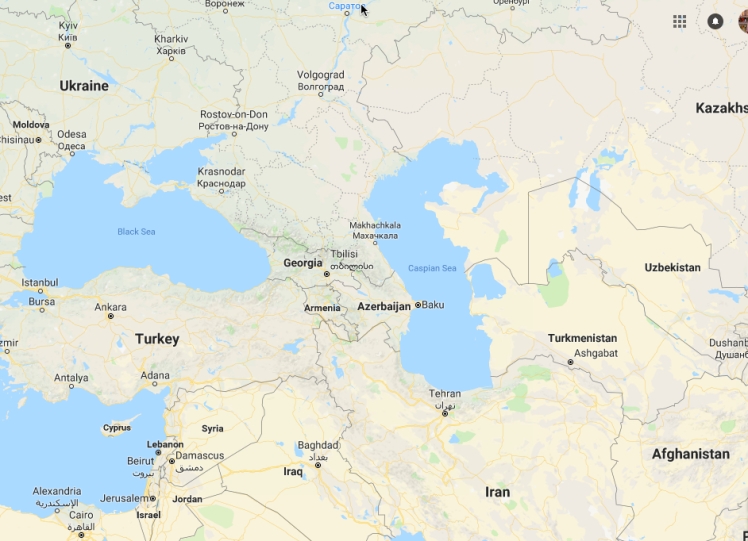
Azerbaijan is a new country, not yet thirty years old, formed after the break up of the Soviet Union in 1991, when the Democratic Republic of Azerbaijan declared their independence. Its main land area is bordered by Russia, Georgia, Armenia, Iran, and the Caspian Sea, but a small piece of the country is completely separate with borders in Armenia and Turkey. These borders and this small piece of land are still a source of intense conflict between Armenia and Azerbaijan. People are dying over these borders.
The people of Azerbaijan are predominantly Muslim, but as my contact at the State Department told me at the time, “They’re mostly Muslim, but you wouldn’t know it.” And so true, at least in the capital city of Baku, where head scarves were almost unheard of, and men and women dress stylishly and cavort together on the streets.
Still, in 2014, when several journalists had been killed by terrorists, I was somewhat apprehensive about going to a Muslim country.
The US State Department says the number of terrorist attacks around the world rose by a third in 2014 compared with the previous year.
In its annual report on terrorism, the State Department says the number of people killed rose by 80%, to nearly 33,000…ISIS specifically sought out religious minorities like Christians and Yazidis in addition to killing Western journalists.
Which brings me to the weekend away with Firengiz at her country cottage in Goyçay. Though completely unfounded by any experience I had had so far, I was a bit afraid of leaving the safety of Baku, the capital city, which is busy, thriving and ultra modern, and where the U.S. Embassy and my university were located. I’m not usually such a scaredy cat, but I was spooked by the whole terrorist threat at the time. I set myself up for a night of terror that in hindsight is humorous, at best, and completely irrational.
Goyçay is a small, rural town to the southwest of Baku. Our driver explained that the highway followed the ancient Silk Road along the Caspian Sea. About an hour into the drive with Firengiz and another colleague, Kamala, we stopped at a roadside restaurant for tea.
I really did stand out in Azerbaijan. Somehow, people knew I was not from there, though, I suppose in a way I was from there since my family roots go back to Eastern Europe. I thought the features of the men rather resembled my own father’s features – dark, swarthy skin, stocky build, piercing eyes, bushy eyebrows. Caucasian.
It was after tea at this restaurant that I began to worry.
I, and the driver as well, noticed a car that was somewhat strangely shadowing us, driving wildly on the shoulder of the freeway to keep abreast of us. The driver dismissed it as just weird, but my mind began to go places. They saw me, I thought. An American. Easy target.
The car followed us as we turned off a long dirt road to head toward the mountains to the west. At intervals the car would pull ahead and then stop to let us drive by, passing us again, and then stopping again. Once, up ahead, I could see it had stopped in the middle of the road. Here it comes, I thought. I’ll be yanked out of the car at gun point. My heart was racing.
It didn’t help that Firengiz, oblivious of this drama playing out on the road, turned around from the front seat and said, “Oh, everyone knows you’re coming to Goyçay, Mary Kay. It’s a small town, and word gets around. They all know you are my guest.”
OK, so now I was completely freaked out. It became not a matter of “if” I would be kidnapped, but “when.” I spent that night sleeping in Firengiz little country cottage making escape plans in my mind, knowing that I would never make it out of there. Where would I go? I was in the middle of nowhere, and alone for all practical purposes. Every tiny noise, I thought, was them at the gate, ready to bust it down and grab me. I didn’t sleep at all. I was quite honestly scared out of my mind.
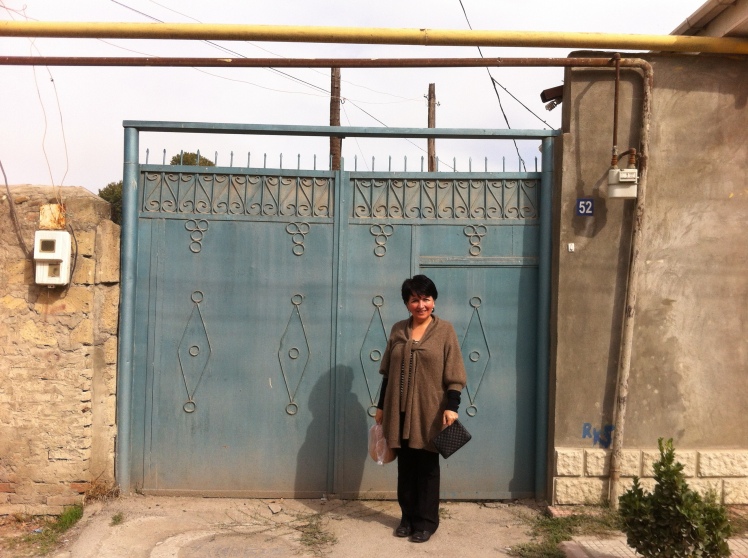
It would make a better story to say that this indeed happened, that I was kidnapped by terrorists, held for ransom, and freed after U.S. pressure to release me. But morning came and I felt rather silly. And tired.
Our breakfast was fresh pomegranates, dates and mangoes from the trees in Firengiz’s front yard, and we talked about our plans for the day, one of which was to have dinner at Fuad’s restaurant. Firengiz was excited to take me there. She told me she had known Fuad since he was a child. That he had always been industrious, selling single cigarettes as a boy on the street, working his way up from one little business to the next, acquiring a parcel of land, planting fruit trees, raising sheep. And now he had opened his own restaurant.
Goyçay is not exactly a modern city. The roads are paved, but the market stalls sell severed sheep’s heads and hooves; an old woman sells brooms she has made out of fallen tree branches, and fresh fish sit in wash basins on the ground in the sun, waiting to be sold. The people are severe, weather-worn, and cautiously friendly. I was happy to be with the town celebrity, Firengiz. I wasn’t sure I would have been warmly welcomed just walking around by myself. I’m a truly adventurous traveler, but I couldn’t imagine coming here by myself. No one but Firengiz, Kamala and I spoke English as far as I could tell.
At 5:00 our driver picked us up for dinner. Fuad’s restaurant sits outside town on a little road heading into the mountains. A man riding a donkey passes by. Farmland all around. But then, there’s a huge building with a sparkling neon sign. This must be the place, I thought, and of course, it was.
Though the place was huge, like a gymnasium with fifty tables ready for diners, there was absolutely no one there except the eager staff. Fuad, himself, greeted us, a 40-something robust man, ruggedly handsome, clearly an old friend of Firengiz, and honored to be hosting a guest from America. She introduced us in Azerbaijani since he didn’t speak English. He suggested we might like to sit outside in the garden area.
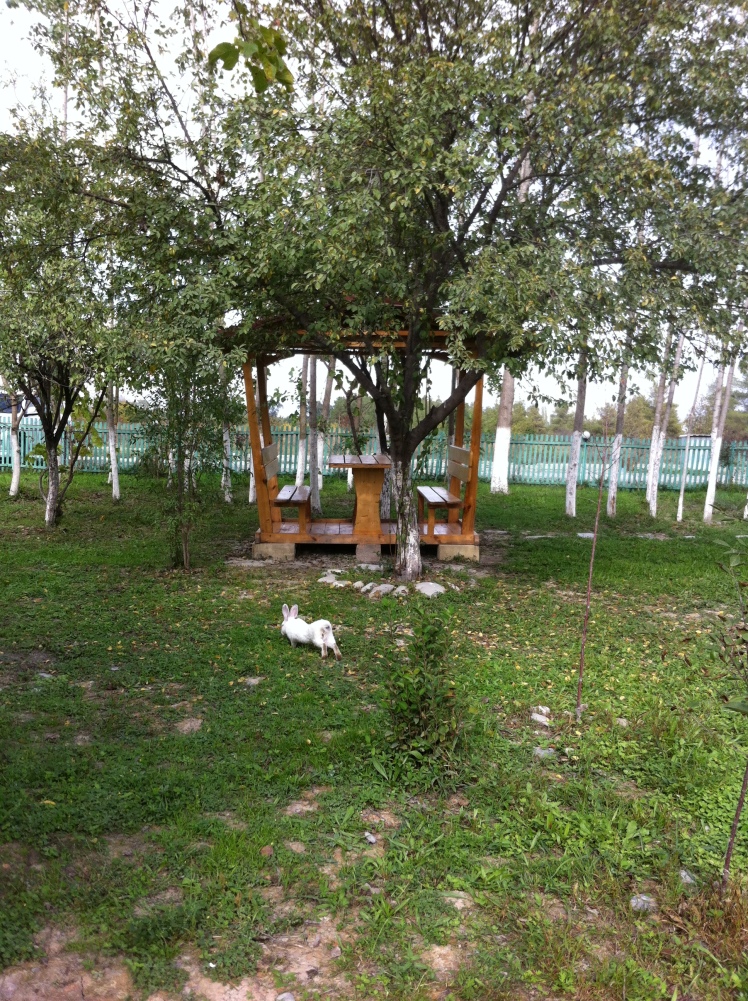
It was an unusually warm October day, and we all agreed that we should take advantage of the warm day, so we exited out the back of the building to the wild (and scrappy-looking) garden area which held four dining Gazebos, scattered cages with turkeys and rabbits and quail, and an outdoor make-shift shed where the cooking took place. In fact, we would be the only diners that evening, with our host Fuad sitting with us, and ushering in each dish.
The first course was fresh salads with tomatoes, and cheeses, served with lavash, the moist and chewy flat bread I became addicted to in Azerbaijan. All the food at Fuad’s, it might be mentioned, was grown organically, and considering the size of this property, it struck me as an amazing feat.
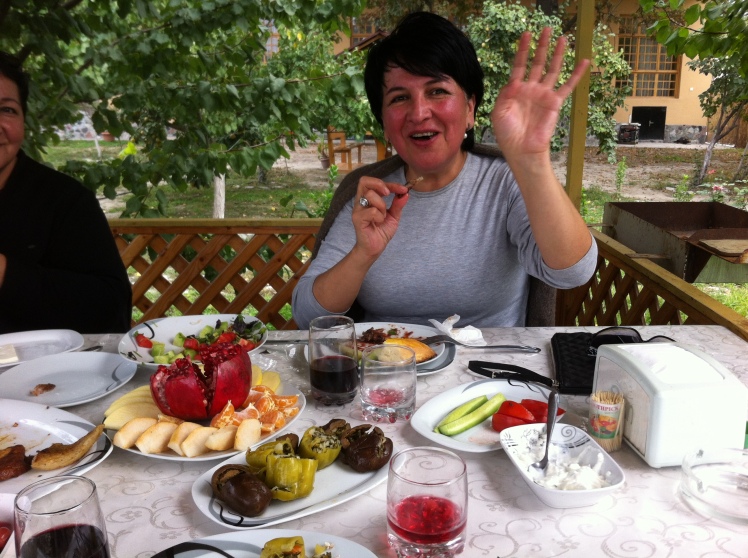
Fuad ordered a bottle of red wine for us and considering that this is a Muslim country and an even more Muslim small town, this also surprised me. There was toasting all around, with Firengiz and Kamala translating everything back and forth. I liked Fuad. He was kind and a bit shy. Charming.
After the salads came the main dish, what Fuad called, Lamb Between the Stones. One of his sons, who are also the cooks, brought it to us on beautiful plates, thick pieces of juicy lamb on homemade slices of bread that were soaking up the drippings.
It was burning hot.
I should note that I didn’t grow up eating lamb. I had tried it on a previous occasion and had decided I didn’t like it. The flavor was a little too strong for me. So, I wasn’t relishing a lamb dinner.
But, oh my. This lamb! Wow! Like buttah. It melted in my mouth, the juices dripping on the plate with every bite. It was delicious! And the piece-de-resistance of the dish was the freshly-made pomegranate sauce that accompanied it. Yes, yes, yes! More, lamb between the stones, please!
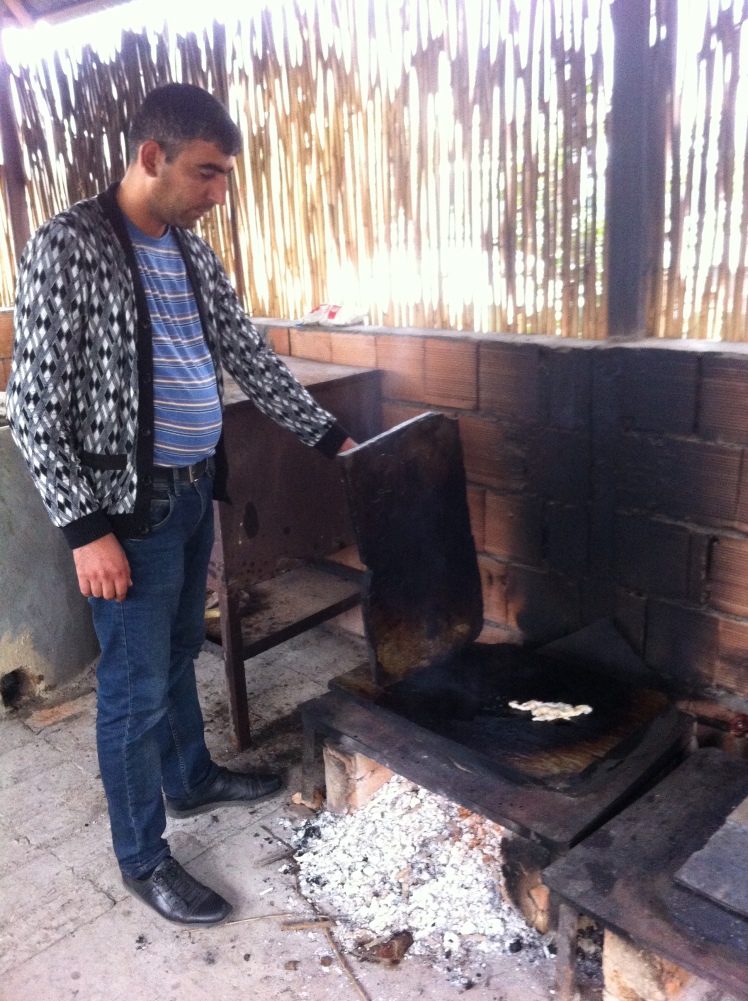
The name, Lamb Between the Stones, comes from the cooking method. As Fuad explained, and showed me, the slices of lamb are placed between two large square stones positioned over an open fire (in the shed out back). The stones are lifted periodically to check the meat, which was otherwise compressed between the hot stones. This is how the shepherds in the mountains used to cook it, Fuad said. He was proud to use this method at his restaurant. Perhaps, his family had been shepherds in those mountains.
These first two courses would be plenty of food for anyone, for sure, but more toasting came, and then the next course: more lamb. This time, lamb kebabs, skewered and stacked into a pyramid over a mound of fresh greens, and more lavash.
More lamb, more veggies, more pomegranate sauce, more wine. I can say for sure that I have never in my life eaten so much food, not even as a child when it was kind of normal to stuff yourself. And I was absolutely stuffed. Bursting. At the seams.
Fuad suggested a walk before dessert.
Yes, please.
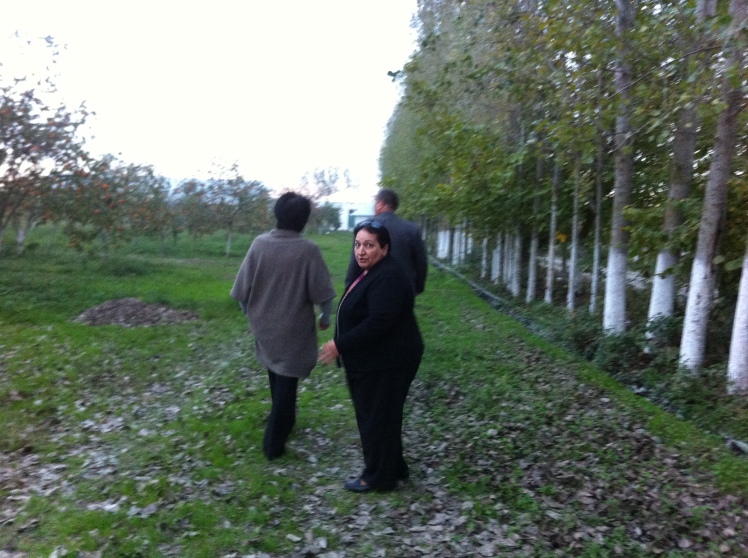
We toured his farm and his orchards as the sun set over the Caucasus Mountains. At the end, we came to a huge pot of boiling pomegranate sauce, which Fuad stirred with a large metal ladle, the red, sweet, and perfect sauce bubbling in the cauldron like a magic potion. He presented a bottle of it to me, along with a fresh-cut rose. Firengiz took a photo of Fuad handing me the flower over the boiling cauldron of sauce.
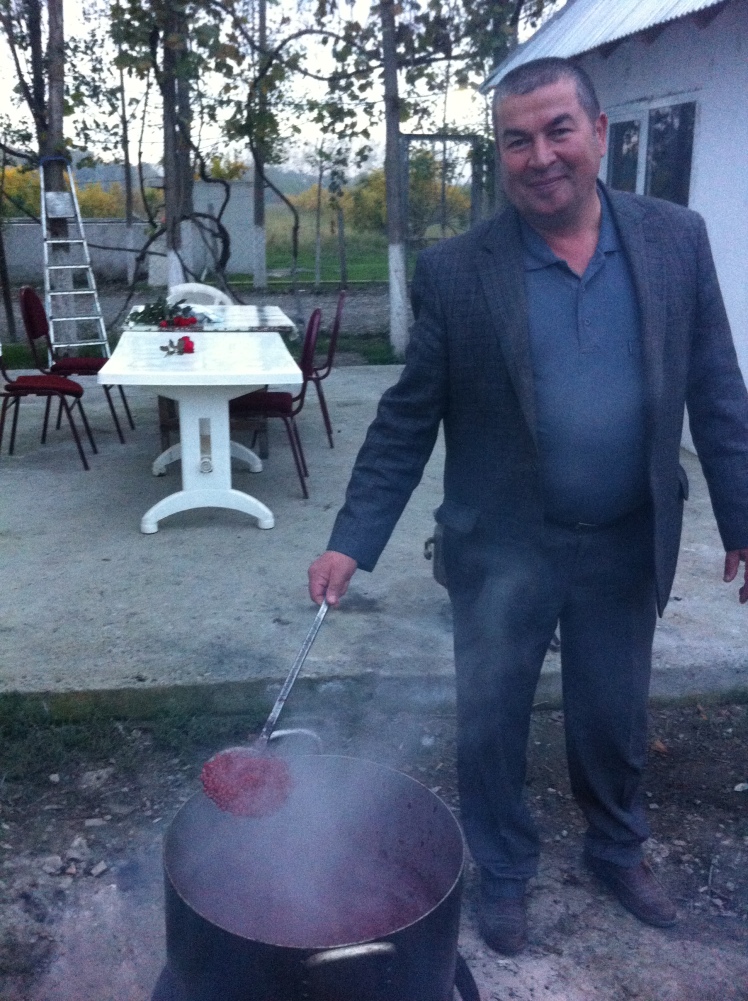
We gathered again in the garden, this time by a stone table, made from a huge, flat river rock, set up with a Russian Samovar for tea, candied apricots, dates, and cookies.
Farm-to-table at Fuad’s.
It was a perfect meal in a perfect setting. And I didn’t get kidnapped. It was one of those moments you can only get while traveling and being open to adventure. Being willing. Saying yes.
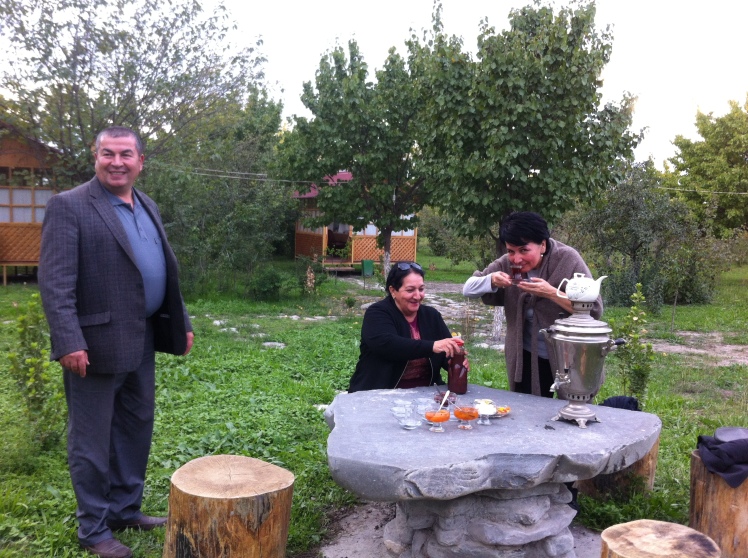
I got a taste of the local, less modern Azerbaijan at Firengiz’s country cottage that weekend. It was lovely, though as an addendum, and for a later story, we went from Fuad’s to Firengiz’s cousin’s house (“we’ll just stop in for a minute,” she said), where we were fed another seven-course meal that night. Not eating was not an option.
That was painful.
Mary Kay Seales is a travel writer and photographer, and also teaches at the University of Washington in Seattle. She has worked for the U.S. State Department in India and Azerbaijan, and is a two–time Peace Corps Volunteer. She is the owner of Closing the Circle: Professional Writing for the Travel Industry. Visit her website at https://www.marykayseales.com

Going Somewhere? https://www.booking.com/s/25_8/mks0ma56






